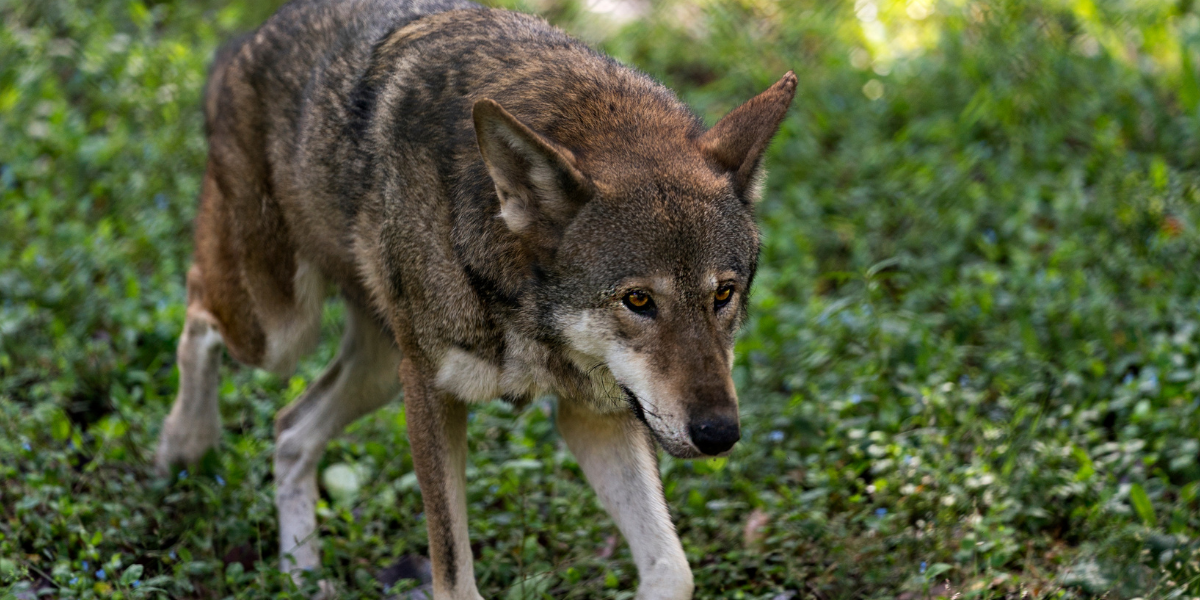Red Wolf Vs Coyote – (Difference between a Red Wolf and Coyote)
The red wolf (Canis rufus) and the coyote (Canis latrans) are two different species but belong to the canid family. Both animals look quite similar in appearance.

That’s why it confuses most people, but there are notable differences. Like, Red wolves have a reddish hue to their fur, while coyotes’ fur has various colors.
Additionally, red wolves are a highly endangered species that inhabit eastern North Carolina, whereas coyotes have a broader distribution throughout North America, eastern Alaska, new england, southern Mexico, and Panama.
There are many other differences that we will discuss in this blog.
The 6 Key Differences Between Red Wolf and Coyote
Red Wolf Vs. Coyote
Red wolves and coyotes are subspecies of gray wolves. Both canid species have striking resemblance that the wildlife biologists that work with the red wolves population at Alligator River National Wildlife Refuge have to do DNA testing to determine the species.
Moreover, coyotes prefer to live alone, not like wolves that live in a pack system. Even they hunt their prey alone not in packs.
There are two types of coyotes existing in America, the eastern and western coyote. The Eastern coyotes and western coyotes are different in size, genetics, and behavior.
But the eastern coyotes have the same characteristics as gray wolves. The reason is that the eastern coyote is a result of interbreeding with the gray wolves. This happened years back when the gray wolves overhunted and reached extinction.
Red Wolf Vs Coyote: Appearance
The coyote (Canis latrans) and the red wolf (Canis rufus) are two distinct canid species that have prominent differences in their appearances.

Coyotes typically are smaller in size weighing between 20 to 50 pounds, with a slender build and a narrow muzzle.
They have a bushy tail, which is often carried low to the ground, and their fur color ranges from gray or brown.
On the other side, red wolves are larger and weigh around 60 to 80 pounds. And have a muscular build with a broader muzzle. They possess distinctive reddish-brown fur, with black markings on their back, ears, and legs.
Red Wolf Vs. Coyote: Size & Weight
Red wolves are larger, with a height of around 26 inches and a weight ranging from 45 to 80 pounds, while coyotes are generally smaller, measuring about 58 to 66 cm standing at the shoulder and weighing between 20 and 50 pounds.
Red Wolf Vs. Coyote: Lifespan
The lifespan of a coyote and a red wolf differs significantly. Coyotes are found throughout North America. The lifespan of coyotes in the wild is around 10 to 14 years, and in zoological settings, this canid species can live up to 20 years.
Red wolves, on the other hand, are an endangered species primarily residing in North Carolina. The lifespan of red wolves in the wild is around 7 to 8 years and more than 15 years in captivity.
Red Wolf Vs. Coyote: Coat Colors
Coyotes and red wolves possess distinct coat colors that set them apart. Coyotes typically exhibit a range of colors, primarily gray, tan, and brown, often mixed with a black or reddish tint.
Their fur appears mottled and can vary depending on the region they inhabit. On the other hand, red wolves, as their name suggests, display a reddish hue throughout their fur.
Their coats are predominantly a rich cinnamon or rusty red, blending with black along their backs and legs. This striking coloration helps red wolves camouflage in their natural habitats.
Red Wolf Vs. Coyote: Vocalization
The vocalizations of coyotes and red wolves exhibit notable differences, reflecting their distinct behaviors.
Coyotes possess a diverse repertoire of vocalizations, including howls, yips, barks, and growls. Their howls are characterized by a high-pitched, wavering sound that can be heard over long distances, serving as a means of communication and territorial marking.
In contrast, red wolves produce lower-pitched howls that are more melodious and less wavering than those of coyotes. They also emit barks, growls, and yips, but their vocalizations are generally less varied.
Coyote Vs Wolf: Conservation Status
The coyotes are endangered species, and the conservation status of the coyote (Canis latrans) is classified as “Least Concern” by the International Union for Conservation of Nature (IUCN).
Despite being historically persecuted and facing habitat loss, the adaptable and resilient nature of coyotes has enabled them to thrive in various ecosystems across North and Central America.
Coyotes have successfully adapted to urban environments and can be found in suburban areas as well.
Their ability to utilize a wide range of food sources and reproduce prolifically has contributed to their wild population stability. However, localized pressures such as hunting coyotes trapping, and diseases impact their populations badly.
The red wolf population is a critically endangered species with only 100 left in the wild. That’s why the red wolf is listed as critically endangered by the International Union for Conservation of Nature (IUCN).
The primary threats to red wolves include habitat loss, fragmentation, and hunting. Efforts to conserve the wolf population are given by the wildlife service, which includes captive breeding programs, reintroduction efforts, and habitat restoration.
Verdict
The red wolf and coyotes might look alike which makes it hard to differentiate. But there are some notable differences among these canid species that help to recognize them.
Such as, coyotes are smaller in size, and red wolves are larger. The coat color of a red wolf contains reddish hues, with cinnamon or rusty red coats.
However, the coyotes have the same colors as red wolves which includes a blend of tan, black, and gray.
Both red wolves, and coyotes howl to communicate, and defend their territory. But there is a slight difference in their howling, like a red wolf’s howl is low-pitched, and is of longer duration.
However, the coyotes make yapping with howling sounds that are high-pitched, and of short duration. Check out the video given below to understand the difference between a coyote, and a red wolf in depth.
Due to the ongoing presence of red wolves and coyotes in shared habitats, the distinction between them remains crucial. Red wolves, an endangered species, possess genetic differences and distinct characteristics from coyotes despite occasional interbreeding. Wildlife agencies like the Fish and Wildlife Service strive to conserve the red wolf population, facing threats of hybridization and habitat loss.
Biologists meticulously study their genomes, confirming their unique ancestry. Coyotes, although similar, remain a separate canine species with distinct behaviors and muzzle structure. Preservation efforts in North Carolina aim to safeguard these distinct canids, preventing further hybridization that could jeopardize the red wolf’s existence.
Frequently Asked Questions
What is the difference between a coyote and a red wolf?
The muzzle of red wolf is shorter, and thicker as compared to coyote’s.
Are red wolves mistaken for coyotes?
Yes, they are usually mistaken for coyotes and shot.
Who is stronger wolf or coyote?
The wolf would win over the coyote.
What is the personality of a red wolf?
They are shy and secretive.









